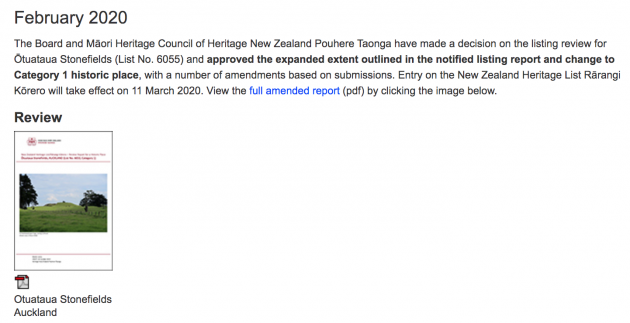A bit of crystal-ball gazing.
Coming soon to a screen near you: The Ihumatao Fix, a must-watch.
Containing fascinating elements of intrigue and chicanery not seen since ‘Dr Strangelove’, the ‘Fix’ has all the hallmarks of political manipulation and leverage more reminiscent of the Helen Clark era than hapless Ardern’s. The tactics are so familiar in fact, we may wonder who’s actually juggling this particular political hot-potato in the background.
Step the First: Purely coincidental to the private-property stalemate caused by the Prime Minister’s flippant comment requesting ‘the development stop until a solution is found’ at Ihumatao, the NZ Heritage Foundation began an ‘independent’ review as to whether the Otuataua Stonefields’ (adjacent and bordering the site of te Ihumatao kerfuffle) Heritage Status 2 should be upgraded and, verily, it has!

Amazing, eh?
Not only has the status been raised but the area of the ‘nationally significant’ site has been expanded to include: well, I don’t need to tell you what ‘Heritage 1’ status has now been attached to, you’re all smart people and can easily guess. But, suffice it to say it’s a minor miracle of both convenience and timing.
To perform this amazement, the minions of the Ministry of Truth have been hard at work, very hard; in fact hard enough to say that rarely in the course of human history has so much doubt been elevated to possible factual status by so few strands of material, and, in the course of just 117 pages (including index and notes), the abstractive threads of speculation imposed upon minimal archaeological evidence has equally rarely been as abundantly spun.
To perform this feat it has been necessary to rope, and tie, 16 ‘possibly’s:
- “Possibly by the fifteenth or sixteenth century, specialised horticultural systems commonly referred to by archaeologists as ‘stonefields’ developed within the site.”
- “possibly other crops brought from tropical Polynesia.”
- “These modifications included the addition of gravel and sand to soil, mulching, fences and windbreaks, and possibly stone rows, to provide shelter for the growing plants.”
to the heritage claims along with the 26 ‘may have’s required to get the status up-tick over the line, so to speak:
- “Over time, there may have been some selection for varieties that were more tolerant of cooler growing conditions or that were faster maturing”
- “the creation of stone walls and related features may have begun by the 1400s or 1500s”
- “In themselves, the T?maki gardens can be seen as an especially widespread expression of intensive horticultural activity in a New Zealand context, in which particularly large-scale production may have occurred”
- “these gardens may have assumed additional importance through their coastal location and strategic position”
- “The range of micro-environments in the vicinity may have meant that varied food production was possible”
- “Stone and earth mounds at the site may have been created for incubating kumara”
- “In the mid-1830s…cultivation on the Ihum?tao Peninsula, at both Puket?papa and Ihum?tao, may have resumed”
And, by way of a bonus to readers, a rare double-happy possible-may have:
- “The range of micro-environments in the vicinity may have meant that varied food production was possible.”
Remembering, of course, that each and every use of “may have” is equally interchangeable with ‘may not have’ and “possibly” with ‘possibly not’ since what Heritage is saying is there is no evidence to support this statement, it’s pure conjecture, just inventive thinking.
To be fair to Heritage NZ, speculative suggestion and intellectual meandering, akin to the illumination of vagueness with fog, are necessarily the archaeologist’s stock-in-trade, without which phantasm-chasing our knowledge of histories and the world, as has been often shown, would ultimately be even gloomier. Let us not forget James Cook was chasing mere speculation in visiting these shores, as was Kupe half a millennium earlier.
To their further credit Heritage NZ do not pretend away the Maori tribal histories placing the intrepid original settler; Toi, circa 1200 AD, and his out-riggers of followers, to their surprise, amongst “Tini [numerous] O Maruiwi’ a people pre-Maori but of Polynesian origin who had existed here “for many generations” but whom modern liberal pakeha academics insist didn’t exist at all, upon his arrival in Tamaki, or the tradition that prior to Maruiwi the area had been peopled by Turehu [the fair-skinned, fair-haired] ‘people from the earth’ [tangata whenua?].
Nevertheless, and regardless of suppositions, superstitions, mystery, fantasy and leaps of (blind) faith, the Heritage status of Otuataua, now including Ihum?tao, is legally upgraded and will be ‘formally’ adopted next Wednesday; March 11th.
That’s curious timing, don’t you think? Why not just tie Heritage 1 status to the date of adoption of the report on 27 Feb? Why the wait? Perhaps it’s some sort of formal notification period to allow for arbitration or legal challenge?
Or, could it be that Cabinet have already been considering the Heritage revelations and a couple of days after the formal adoption of the 11th announce, on or about 13th March, while the news is concentrated on the anniversary of the diabolical deeds of the lone-Australian madman, and now with coronavirus increasingly shouting out all other headlines, that the government will purchase from Fletchers all of the Ihum?tao protest site in view of its newly revealed and updated ‘importance’ to ‘all New Zealanders’, the price for which purchase (probably circa $60-75M) the taxpayer will never be informed of due to Fletcher’s being a private company, commercial sensitivity, and all that jazz.
The prime minister will be otherwise and fully employed next weekend and all questions about Ihum?tao will be ‘ill-considered’, ignored or otherwise warned-off as disrespectful. Call me a cynic if you like, but politics is cynicism writ large.
Watch this space.
If you enjoyed this BFD article please consider sharing it with your friends.

